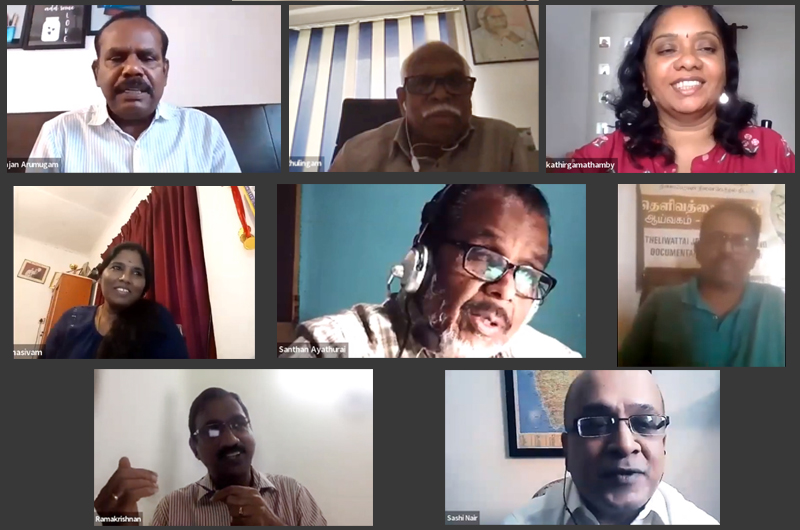More than two centuries have gone since a large number of poor people from different parts of Tamil Nadu, especially southern districts, were taken to Sri Lanka till about the late 1930s to be employed, initially in coffee plantations and, later, in tea and rubber estates. Needless to say, they largely belonged to, what is popularly called, Dalit communities or Scheduled Castes. Over the years, the community has come to be known as ‘Indian Tamils’, ‘Tamils of recent Indian origin’, ‘Indian Origin Tamils’ or ‘Plantation Tamils’. However, members of the community prefer to call themselves as Malaiyaha Tamils (Hill Country Tamils). A majority of them, if not the predominant section of them, still works in plantations. The youth of the community are moving out of the estates to work elsewhere as they want tread a path different from the one taken by their elders.
The contribution of the Hill Country Tamils to the economy of Sri Lanka can be gauged from the fact that tea exports had netted $1.26 billion in 2022, a post-COVID-19 year, accounting for 10 per cent of export earnings. While the community’s leaders put the population of the Hill Country Tamils at 1.6 million, the 2012 Census puts the figure at about 840,000 — 4 per cent of the country’s population. According to UN Habitat, there are about 244,500 families and a population of 966,700 living in the plantation sector in Sri Lanka, the data of which ust have been related to 2016 or 2017. The UN agency also identifies the community as the main component of the population in the plantations.
The community is concentrated in the district of Nuwara Eliya, accounting for 45 per cent, and in Kandy with 10 per cent, both in the Central Province, going by the 2012 Census. The remaining 45 per cent of the Tamils is essentially distributed among Badulla in Uva Province with 18 per cent, Ratnapura and Kegalle (both in Sabaragamuwa) with 7 per cent and 5 per cent, respectively. While Colombo and Kalutara, both in the Western Province, and Matale (Central Province) have 3 per cent each, the balance 3 per cent of the population is spread evenly over Galle and Matara (both in the Southern Province) and Gampaha (in the West).
A 2019 study on the Hill Country Tamils identified three drivers of structural disadvantage that affected the community. The drivers were the distancing of the State (exemplified by the prolonged exclusion of the Tamils from governance structures, welfare institutions, and public services), dependency on the plantation companies that fulfil a range of everyday functions and needs on the plantations and the brokerage by plantation trade unions. “Together, these drivers perpetuate many of the conditions associated with statelessness and have prevented the Hill Country Tamils from experiencing meaningful citizenship,” points out the study, carried out by Verite Research and the Institute on Statelessness and Inclusion.
Housing remains a major problem for the community. The UN agency said: “line rooms [which are all of 200 sq ft] numbering about 160,000 in the estates, are now in a state of disrepair.” India has been funding a housing project to cover 14,000 houses for the community. According to the India’s Finance Minister Nirmala Sitharaman, 3,700 houses out of 4,000 houses, the work on which was taken up in 2016, have been handed over to beneficiaries. Another 10,000 houses are to be taken up for construction.
There are other issues afflicting the community. Other markers such as a high poverty headcount ratio of 10.9 per cent as against the national average of 6.7 per cent, lower literacy rate of 86.1 per cent compared to the national rate of 95.7 per cent, high infant mortality rate of 29 per 1,000 live births while Sri Lanka’s overall figure is 9.7 per 1,000 live births combine to make the community one of the country’s most backward ones.
Conscious of the complexity of issues and problems afflicting the community of the Hill Country Tamils, the Press Institute of India has decided to organise a webinar to discuss different aspects of challenges involved in ensuring that the community becomes strong and vibrant, and is able to fulfil its aspirations in the best possible manner. The virtual discussion titled ‘200 years of Hill Country Tamils in Sri Lanka – a saga of accomplishments and travails’ was conducted on 19th December, 2023.
Speakers from Sri Lanka were P. Muthulingam, founder, Institute of Social Development, Kandy, who spoke about Hill Country Tamils: History, contributions and importance in Sri Lankan society; Dr Yasodara Kathirgamathamby, senior lecturer, Department of Legal Studies, Open University of Sri Lanka, who dwelt on the Role of women among Hill Country Tamils in Sri Lankan economy; Jeeva Sathasivam, journalist, who described the Impact of the civil war on Hill Country Tamils; Ayathurai Santhan, bilingual writer, Jaffna, who provided a view from the North of Hill Country Tamils; Mohana Dharshini, secretary, Women’s Liberation Thought Organisation, who spelt out the Challenges before Hill Country Tamils, especially women.
A. Natarajan, India’s former assistant high commissioner in Kandy and consul-general of India in Jaffna, was the chief guest. He recalled his days in the Hill Country and how it was a pleasure serving the people there.
T. Ramakrishnan, senior journalist and author of An Ethnic Conflict and An Accord made the initial observations and anchored the discussion. Sashi Nair, Director, Press Institute of India, welcomed everybody attending.



 from Webdoux
from Webdoux